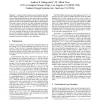Free Online Productivity Tools
i2Speak
i2Symbol
i2OCR
iTex2Img
iWeb2Print
iWeb2Shot
i2Type
iPdf2Split
iPdf2Merge
i2Bopomofo
i2Arabic
i2Style
i2Image
i2PDF
iLatex2Rtf
Sci2ools
103
Voted
DAC
1997
ACM
1997
ACM
More Practical Bounded-Skew Clock Routing
: Academic clock routing research results has often had limited impact on industry practice, since such practical considerations as hierarchical buffering, rise-time and overshoot constraints, obstacle- and legal location-checking, varying layer parasitics and congestion, and even the underlying design flow are often ignored. This paper explores directions in which traditional formulations can be extended so that the resulting algorithms are more useful in production design environments. Specifically, the following issues are addressed: (i) clock routing for varying layer parasitics with nonzero via parasitics; (ii) obstacle-avoidance clock routing; (iii) a new topology design rule for prescribed-delay clock routing; and (iv) predictive modeling of the clock routing itself. We develop new theoretical analyses and heuristics, and present experimental results that validate our new approaches. 1 Preliminaries Control of signal delay skew has become a dominant objective in the routing of...
| Added | 06 Aug 2010 |
| Updated | 06 Aug 2010 |
| Type | Conference |
| Year | 1997 |
| Where | DAC |
| Authors | Andrew B. Kahng, Chung-Wen Albert Tsao |
Comments (0)

